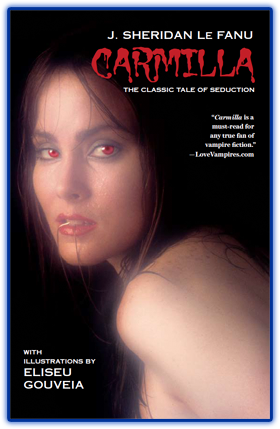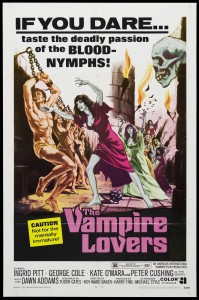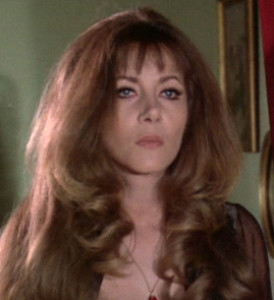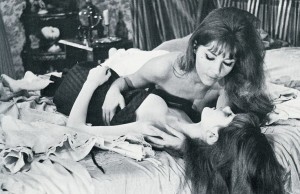 One hundred and forty-five years ago, J. Sheridan Le Fanu’s classic vampire tale, Carmilla, debuted in serialized form in the pages of the magazine Dark Blue—running from the December 1871 issue through March 1872—and was then reprinted in Le Fanu’s short story collection, In a Glass Darkly, published later that year.
One hundred and forty-five years ago, J. Sheridan Le Fanu’s classic vampire tale, Carmilla, debuted in serialized form in the pages of the magazine Dark Blue—running from the December 1871 issue through March 1872—and was then reprinted in Le Fanu’s short story collection, In a Glass Darkly, published later that year.
If you’re unfamiliar with what’s probably Le Fanu’s most famous work, here’s the back-cover copy from the edition that we published in 2010, which has become the most popular title in our Illustrated Classics line:
Before Edward and Bella, before Lestat and Louis, even before Dracula and Mina, there was the vampiric tale of Carmilla and Laura.
Living with her widowed father in a dreary old castle in the woods of Styria, Laura has longed to have a friend with whom she can confide; a friend to bring some excitement to her pastoral lifestyle. And then Carmilla enters her life.
Left by her mother in the care of Laura’s father, Carmilla is young, beautiful, playful—everything that Laura had hoped to find in a companion. In fact, the lonely girl is so thrilled to have a new friend that she is willing to overlook the dark-haired beauty’s strange actions…which include a disturbing, growing obsession for her lovely hostess.
Carmilla, it seems, desires more than just friendship from Laura….
The influence of Carmilla on horror fiction has lasted to this day, serving as an inspiration for numerous writers—including Bram Stoker in the creation of the vampire brides who threaten Jonathan Harker in Stoker’s seminal novel, Dracula—and filmmakers.
 Today we’re taking a look at one of those movies: The Vampire Lovers. Released in 1970 through a collaboration between Hammer Films and American International Pictures, it was the first entry in what became known as Hammer’s “Karnstein Trilogy,” the others being Lust for a Vampire (with Yutte Stensgaard taking over the role of Carmilla from Ingrid Pitt) and Twins of Evil, both released in 1971. (Spoiler: “Karnstein” comes from Mircalla Karnstein, Carmilla’s real name.) All three are loosely based on Le Fanu’s novella, although The Vampire Lovers comes closest to being a direct adaptation.
Today we’re taking a look at one of those movies: The Vampire Lovers. Released in 1970 through a collaboration between Hammer Films and American International Pictures, it was the first entry in what became known as Hammer’s “Karnstein Trilogy,” the others being Lust for a Vampire (with Yutte Stensgaard taking over the role of Carmilla from Ingrid Pitt) and Twins of Evil, both released in 1971. (Spoiler: “Karnstein” comes from Mircalla Karnstein, Carmilla’s real name.) All three are loosely based on Le Fanu’s novella, although The Vampire Lovers comes closest to being a direct adaptation.
Sometime in the nineteenth century, in the Duchy of Styria—which in the real world is located in southeast Austria, where it’s a good bet not everyone sounds like they’re in a British repertory company—Laura von Spielsdorf (Pippa Steel) is celebrating her birthday at a lavish ball thrown by her father, the General (Hammer veteran Peter Cushing). Among the guests are The Countess (Dawn Adams) and her “daughter,” Marcilla (Ingrid Pitt). The Countess explains to the general that she must leave to see a dying friend; the General invites Marcilla to stay as his guest until her mother returns. Marcilla, who’s been making moon eyes at Laura all evening, agrees.

Ingrid Pitt as Carmilla/Marcilla
The girls become friends, but over time Laura begins suffering from nightmares of a giant cat entering her room and draining her life. Soon enough, she dies, and a doctor spots the telltale bite marks of a vampire on her breast. Marcilla, meanwhile, has mysteriously disappeared…
Not long after, businessman Roger Morton (George Cole) and his daughter Emma (Madeline Smith)—who was Laura’s best friend—come across a carriage broken down in the road; its passengers are The Countess and her “niece,” Carmilla (would you be surprised to discover she’s really Marcilla with a few letters shifted around in her name?). The Countess leaves Carmilla in Morton’s care, Carmilla takes an instant liking to Emma…you can see where this is going, right? If Morton doesn’t pay attention to what’s going on in his home, it’s a certainty that Emma—and her governess, Mme. Perrodot (Kate O’Mara)—will be following Laura to an early grave with Carmilla’s help…
As adaptations go, The Vampire Lovers does a good job of translating the story to the screen, with some changes. Laura is the protagonist/narrator of Le Fanu’s novella; here her name is used in place of the novella’s Bertha, and she becomes Carmilla’s first victim before the newly created character Emma steps in to fill novella-Laura’s part. But it’s Pitt’s performance that keeps you riveted, her Carmilla equal parts seductress and lost soul, a passionate monster who devours the objects of her affection no matter how often she tells them she loves them. She dominates the film when she’s on screen, and her influence is still felt even when the scene shifts to other characters.

Ingrid Pitt and Madeline Smith
Of course, being a Hammer film, a great deal of focus is placed on the sexuality of the women, with Carmilla casually disrobing at various points to entice her male and female victims (and the movie watcher!), and draining blood from Laura and Emma by biting them on the breast instead of the neck (thus providing a reason for spotlighting Steel’s and Smith’s bosoms in extreme close-ups). And then there are the long wooden shafts used to stake Carmilla and the other members of the Karnstein family—you don’t need to be Sigmund Freud to see the phallic symbolism at play.
Bottom line? A fairly faithful and slightly expanded adaptation of Le Fanu’s novella, combined with Ingrid Pitt’s entrancing portrayal of Carmilla, makes The Vampire Lovers a definite must-see for vampire fans. Come for the sexy-vampire time, stay for the gothic atmosphere. Even if you’ve never read Carmilla (which you really should, since we have our own edition for sale), you’ll find The Vampire Lovers to be a well-done vampire film on its own.
The Vampire Lovers (1970)
Starring Ingrid Pitt, Peter Cushing, Madeline Smith, Kate O’Mara, and George Cole
Directed by Roy Ward Baker
Screenplay by Tudor Gates
Adaptation by Harry Fine, Tudor Gates, and Michael Style
Produced by Hammer Films and American International Pictures
Carmilla—the SWC Illustrated Classics edition, which features six original drawings by Eliseu Gouveia—is available in print and digital formats, so visit its product page for ordering information.







Pingback: Watching Carmilla Become One of The Vampire Lovers | The Saga of Pandora Zwieback